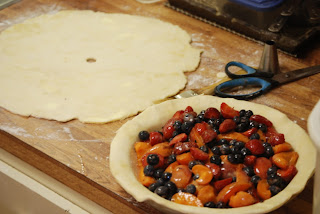“Some
days in late August at home are like this, the air thin and eager like this,
with
something
in it sad and nostalgic, and familiar.”
- from The Sound and The Fury by William Faulkner
- from The Sound and The Fury by William Faulkner
Summer is winding down. The light at dusk changes, more
yellow reflecting on the leaves. Autumn arrives in a few weeks.
If you are a farmer’s market shopper like me, you will find
all you need to make a succotash, whether it’s exactly like this one or not.
It’s open to personal interpretation and preferences.
Succotash is the familiar vegetable dish that comes to us from the
Native Americans. Variations of it appear across the country. I grew up with it made with lima beans. No thank you.
The basics are
corn and beans, but it becomes more interesting with the addition of other
seasonal offerings, such as squash, bell pepper, or sweet cherry tomatoes. I
found fresh cranberry beans but any bean will work, even green beans or wax
beans. It’s the spirit of the dish that’s important.
I made this one night as a base for soft shell crabs (for me) and salmon for my red haired food co-pilot. It pairs with anything.
A fresh shell bean, such as a cranberry bean, needs time to
cook, about 20 to 30 minutes depending on the size of the beans you find inside
the pod. If you use a shelling bean, they can cook while you put the succotash
together, then when the beans are ready, drain them and add stir them into the succotash. A
fresh green bean or wax bean just needs to be sliced and cooked with the other
vegetables until tender. Add the corn last since it requires the least amount
of cooking time.
It’s easy.
Late Summer Succotash
for two servings
¼ pound cranberry beans (1/2 cup beans when shelled)
2 ears corn
½ cup diced onion
¼ cup diced red bell pepper
1 or 2 cloves garlic, minced
10 to 12 cherry tomatoes, halved
2 Tablespoons fresh basil, torn
salt and freshly ground black pepper
olive oil, for cooking
1 Tablespoon unsalted butter, optional
1. If you are using a fresh shelling bean, remove them from
their pods and set aside. Fill a
medium-sized saucepan with about 2 cups of water, place it onto the stove, and bring it to a boil. When the water is boiling, add the beans and cook until
tender, about 20 to 30 minutes.
2. Husk the corn. Cut the kernels from the cobs. The easiest
way to do this is to stand the corn upright in a bowl and slice down the length of the cob to cut the kernels from
the cob. The falling corn will stay in the bowl. Set the corn aside.
3. Place a large sauté pan over medium-high heat. When the
pan is hot, swirl in about 2 tablespoons olive oil. Add the onions and bell
pepper to the pan and cook for about 2 minutes until the onions become
translucent. Add the garlic and cook until fragrant, about 30 seconds. Add the
cherry tomatoes and season lightly with salt and ground black pepper. Cook for
about 4 minutes to soften the tomatoes. Add additional olive oil as needed if
the pan appears dry. (If you are using a fresh green or wax bean, add them now
along with ½ cup of water to help cook the beans). If you are using a shelling
bean and they’re still cooking, remove the pan of vegetables from the heat and
wait until the beans are tender. When the beans are tender, drain them and add
them to the pan. Add the corn and torn basil to the pan with about ¼ to 1/3 cup
water. Let the succotash simmer gently for about 2 to 3 minutes. Taste and adjust the
seasoning, if necessary. Add the tablespoon of butter to the succotash, if using, and
stir.
It’s ready.
























